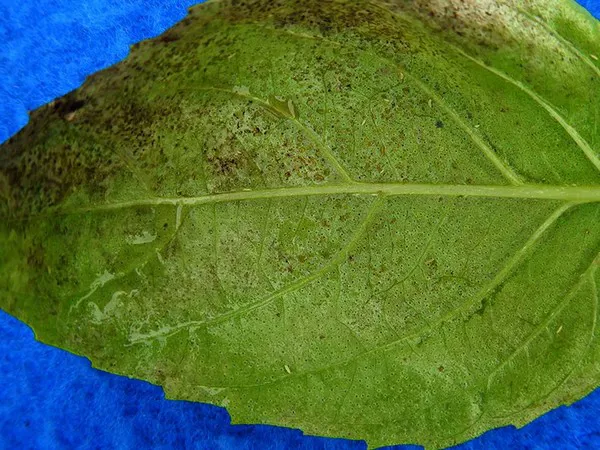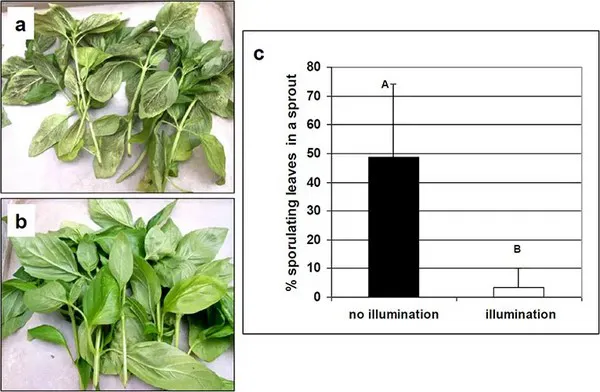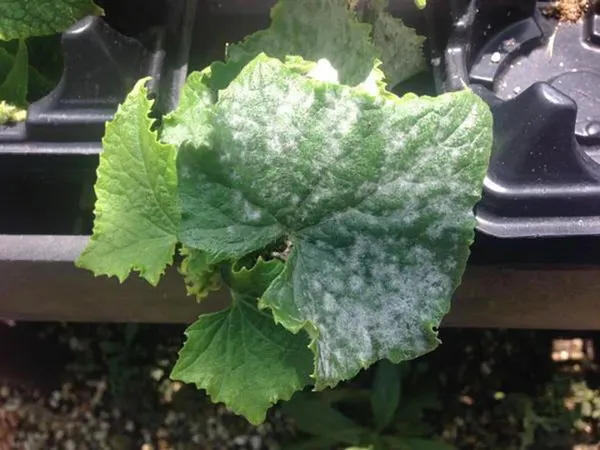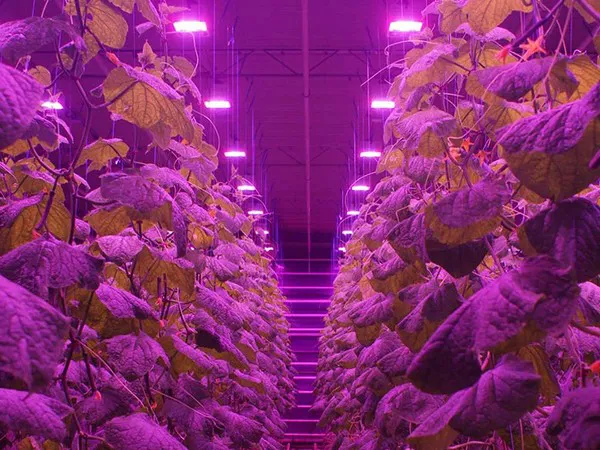Every basil grower’s worst nightmare is Basil Downy Mildew. You walk down the aisles, peer across the canopy, and then “Oh No!”. You see leaf yellowing and fuzzy purple growth. The once sweet smell of herbaceous goodness no longer smells so sweet knowing you have hours not days to react.

Image source: Cornell University
This awful gut feeling can be felt by any plant grower, and most know it too well. In cucumbers, it’s all about powdery mildew. In cannabis, white powdery mildew.
Traditional techniques call for using fungicides and adjusting your environment. These are still important methods given the severity of the situation, but there’s now a new promise of prevention strategies using light.
First, what is Basil Downy Mildew?
Basil that’s become infected with downy mildew will begin to turn yellow and may be mistaken for a problem with nutrition. This yellowing may be followed by dark brown or purple fuzz as sporulation continues to develop. Peronospora belbahrii is the Latin name for basil downy mildew.
The promise of using light to stop downy mildew in basil
Light has many effects on plants and other organisms’ physiology. In the case of downy mildew, disrupting the dark period with red light while managing temperature and humidity has been shown to prevent the production of spores in sweet basil.

Image source: Cohen Y, Vaknin M, Ben-Naim Y, Rubin AE (2013) Light Suppresses Sporulation and Epidemics of Peronospora belbahrii. PLoS ONE 8(11): e81282. https://doi.org/10.1371/journal.pone.0081282
Researchers at Bar-IIan University in Israel found that low-intensity red light inhibited sporulation of Peronospora belbahrii on sweet basil when applied during the dark period while maintaining moderate temperatures and low humidity.
Infected basil leaves were exposed to 5 or 10 micromoles of blue, green, red, or incandescent light. They were incubated at 20°C in moist conditions for 20 hours in a growth chamber.
Results showed that red light (at a peak of 625 nanometers) inhibited 99.7% sporulation regardless of the leaf surface exposed to light! Light strongly inhibited sporulation on leaves incubated at 15-27°C, but not on leaves incubated at 10°C.
What to do about powdery mildew in cucumbers
In the case of powdery mildew cucumber diseases, blue light has been shown to prevent the spread of disease by preventing the release of fungal spores.

Researchers at the Department of Chemical Biological Sciences in the Women’s University of Tokyo found that blue light can prevent the release of powdery mildew spores from developed fungal bodies and prevent the spread of disease melons.
Melon plants, inoculated with Podosphaera xanthii were grown in growth chambers under purple, blue, green, orange, red and broad-spectrum light, as well as in complete darkness and in a greenhouse under solar light. Light treatments were used on the powdery mildew for 14 days under continuous illumination of 59.5 micromoles of light.
Results showed that, while conidium fungal spores were still produced under all light treatments, spores were not released from conidiospores (or reproductive fungal spores) under blue light in the growth chamber. This research proves promising for preventing the spread of mildew in cucumbers, melons, and other cucurbits.
What this means for the future of Basil Downy and Powdery Mildew
These researchers have shown that light quality has the potential to stop the spread of fungal pathogens. It’s possible that in many cases, light spectrum must be readily controlled to inhibit the spread of mildew and other disease types.
In the case of fungal pathogens, light has been shown to suppress disease by disrupting the pathogen’s reproductive cycle and by exploiting natural adaptations in its circadian rhythm.

Depending on the fungi and plant species in question, this disruption can be a response to specific light wavelengths, the duration of light period, duration of dark period, total light intensity or a combination of these factors.
Light can also suppress disease by increasing the plant’s secondary metabolite production, which enhances the plant’s ability to defend against attack.
Using light to suppress disease in your operation
Research on light’s ability to suppress plant disease is in its early stages, but there are some important findings that can help guide growers when trialing light treatments for disease suppression.
- Light treatments are plant and pathogen-specific, so it’s important to seek out information for light treatments specific to your particular crop and pathogen.
- Depending on whether a disease is suppressed by enhancing the plant’s defense system or disrupting the pathogen’s physiological processes, light treatments may need to be applied throughout the plant’s entire growth cycle, limited to a short exposure or applied during a specific growth period in order to be effective.
- Like all crop production processes, light treatment is only one part of the integrated strategy. Environmental factors like temperature and humidity, as well as production processes like irrigation and crop management, should be considered as part of an integrated pest management plan.
For more information: LumiGrow
LumiGrow
800-514-0487
info@lumigrow.com
www.lumigrow.com
